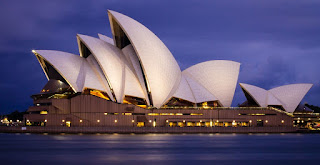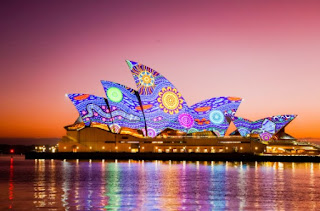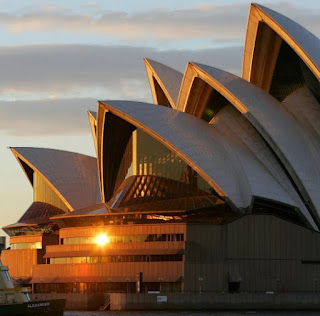Sydney Opera House
The Sydney Opera House is one of the most iconic and recognizable landmarks in the world, located on Bennelong Point in Sydney, Australia. Its unique design and architectural significance have made it a UNESCO World Heritage Site. The history of the Sydney Opera House spans several decades and involves a series of events, challenges, and triumphs. Here's an overview:
Concept and Design (1940s-1950s) :
The idea of constructing a world-class performing arts venue in Sydney was first proposed in the late 1940s. In 1955, the New South Wales government held an international design competition to select an architect for the project. More than 200 entries were submitted from around the world, and the Danish architect Jørn Utzon's design was chosen as the winner in 1957. His design featured a series of sail-like shells that would serve as the roofs for the main performance halls.
Construction (1959-1973) :
Construction of the Sydney Opera House began in 1959, but it soon encountered numerous challenges, including technical difficulties with the design and escalating costs. The engineering complexities of the unique structure, especially the shells, posed significant challenges. Despite the difficulties, the construction continued, and the shells were finally completed in 1967.
Opening and Inauguration (1973) :
The Sydney Opera House was officially opened by Queen Elizabeth II on October 20, 1973. The opening ceremony was a grand event, and it marked the beginning of a new era in Australia's cultural scene. The first performance held at the Opera House was the opera "War and Peace."
Cultural Significance :
The Sydney Opera House quickly became a symbol of Australia's cultural identity and a significant attraction for tourists from around the world. It has hosted numerous iconic performances, including concerts, opera, ballet, theater, and other cultural events. The venue has welcomed renowned artists and performers, solidifying its status as one of the world's premier performing arts centers.
Architectural Legacy :
Jørn Utzon's innovative and groundbreaking design has had a lasting impact on the world of architecture. The Sydney Opera House is considered a masterpiece of modern architecture, and its design has influenced countless structures globally. In 2003, Utzon was awarded the Pritzker Architecture Prize, often referred to as the Nobel Prize of architecture, for his exceptional contribution to the field.
UNESCO World Heritage Site (2007) :
In 2007, the Sydney Opera House was inscribed as a UNESCO World Heritage Site, recognizing its outstanding cultural and architectural significance. It was praised as an excellent example of 20th-century design and engineering, blending creativity and technical achievement seamlessly.
The Sydney Opera House stands as a testament to human imagination, perseverance, and the pursuit of excellence in the arts. It continues to be a vibrant cultural hub and a symbol of Australia's artistic heritage on the global stage.
Attraction :
The Sydney Opera House is a world-famous architectural marvel that draws millions of visitors each year. Its unique and striking design, coupled with its location on Sydney Harbour, makes it one of the most iconic landmarks in the world. Tourists and locals alike are captivated by its beauty and cultural significance.
Facts About the Sydney Opera House :
Unique Design : The most distinctive feature of the Sydney Opera House is its series of sail-like shells that form the roofs of its performance halls. There are a total of six shells, each made of precast concrete panels. The design is the result of architect Jørn Utzon's groundbreaking vision, inspired by nature and geometry.
Jørn Utzon's Inspiration : The inspiration for the Opera House's design came to Jørn Utzon while peeling an orange. The segments of the orange served as a visual representation of how to construct the interconnected shells. This organic and innovative approach made the Sydney Opera House a pioneering example of expressionist architecture.
Construction Time : The construction of the Sydney Opera House took a total of 14 years, from 1959 to 1973. The complexity of the design and numerous engineering challenges contributed to the extended construction timeline.
Cost Overruns : The original cost estimate for building the Sydney Opera House was around AUD 7 million. However, the actual cost escalated significantly during construction, eventually reaching over AUD 100 million. The financial burden and delays led to conflicts, and Jørn Utzon resigned from the project in 1966.
UNESCO World Heritage Site : In 2007, the Sydney Opera House was inscribed as a UNESCO World Heritage Site, joining the ranks of other global landmarks of cultural and historical significance. It was recognized for its outstanding architectural value and its status as an iconic symbol of Australia's creative achievements.
Performance Spaces : The Opera House consists of multiple performance spaces, including the Concert Hall, which can accommodate around 2,700 people and houses the world-renowned Sydney Symphony Orchestra. The Joan Sutherland Theatre is the Opera House's main opera and ballet venue, with a seating capacity of about 1,500.
Diverse Program : The Sydney Opera House hosts a diverse range of performances and events, encompassing classical and contemporary music, opera, theater, dance, comedy, and more. It hosts over 2,000 events annually, attracting millions of visitors from all over the world.
Lighting Projections : The Sydney Opera House frequently becomes the canvas for impressive lighting projections during special occasions and events. Its sail-like shells have been illuminated with spectacular light displays, transforming the building into a stunning visual spectacle.
Overall, the Sydney Opera House remains an enduring symbol of architectural ingenuity and artistic excellence, attracting visitors with its breathtaking design and captivating cultural offerings. .





0 Comments